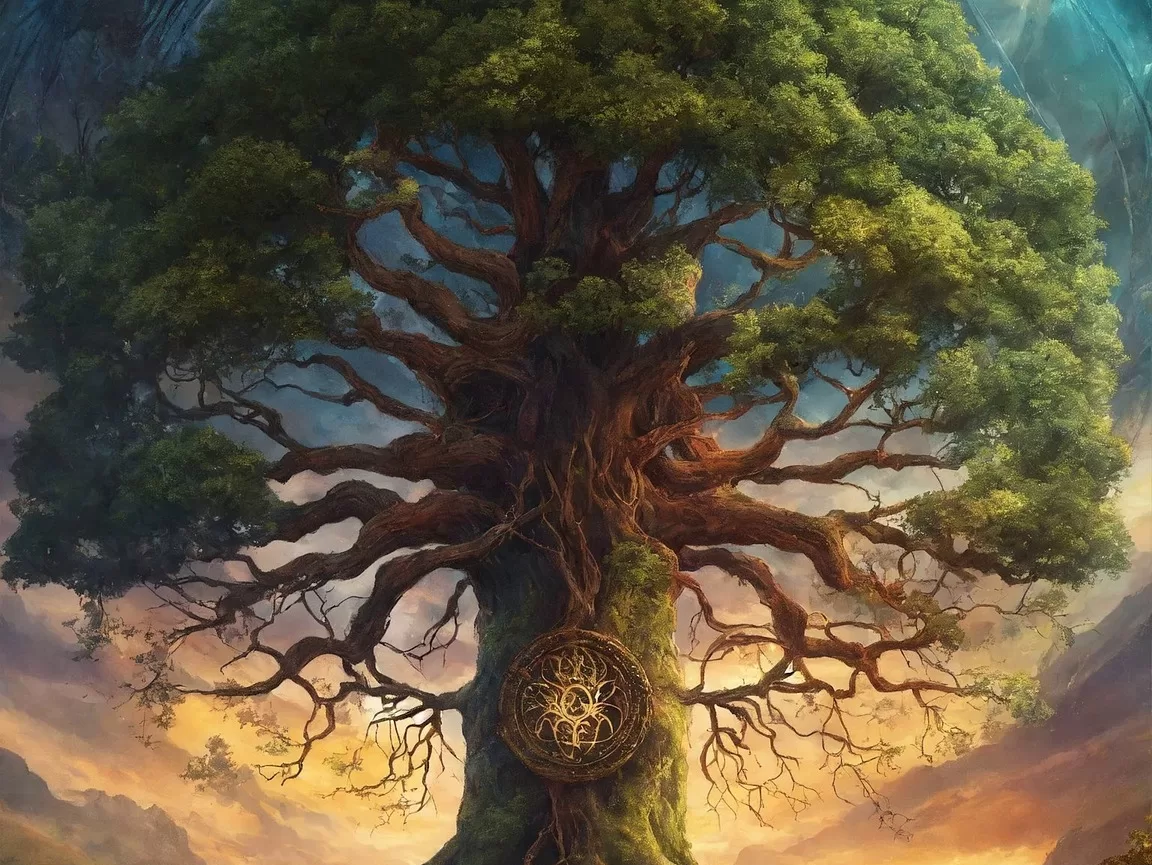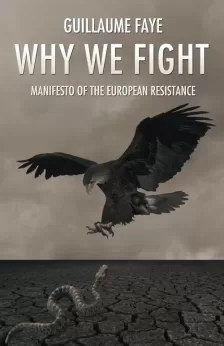Throughout the entirety of human history, in numerous traditions all over the Earth, trees have played — and still play — a central and symbolic role. Most of our contemporaries are familiar with the various trees in the Abrahamic religions: the Kabbalistic Tree of Life in Judaism, which appears in the Garden of Eden along with the Tree of the Knowledge of Good and Evil, similarly fundamental to Christianity, which is also simply known as “The Tree” (or the Tree of Immortality) in Islam. Furthermore, we find various trees in Indo-European traditions and spiritual practices; with regards to the latter, there are practical examples, such as vṛkṣāsana in yoga, as well as the Tree of Awakening (or Bodhi Tree) in Buddhism, where prince Siddhartha Gautama sat to attain Enlightenment. In the Bhagavad Gita, Krishna speaks of the eternal Aśhvatth Tree, a tree that is also mentioned in the Vedas. In Nordic and Germanic cosmology, there is Yggdrasill, which, according to the Poetic Edda, stands forever green over the Well of Urðr, where the past, present, and future determine the fates of men.
There are many more examples to be found, but it would be unfeasible to provide a comprehensive overview of all the trees that played a role in the World of Tradition, let alone to identify all overlapping and distinctive elements as laid down in various mythologies and sacred scriptures in a simple essay. Nevertheless, it is worthwhile to note that, although the modern world is wholly profane and thus disregards any sacred symbolism, including that of the tree, it is telling that the tree still speaks to the imagination of the modern mind.
Unsurprisingly, the image of the tree is still used in various life sciences, from biology to geology, either as a metaphor or pictorial explanation. Especially the concept of the Tree of Life has proven rather persistent: even Charles Darwin relied upon the symbol of the tree to represent the affinities of all living beings; today, the “phylogenetic tree” is still widely used. More specifically, with regards to us, human beings, there also remains the family tree, as the tree is the only way to adequately depict our genealogy, our relationship to each other and our ancestors.
Of course, the family tree is an age-old phenomenon, not a modern invention. Already in ancient times, the family tree was used to document family histories, most notably the bloodlines of prophets, saints, sages, the ruling dynasties and imperial families. But nowadays, to the majority of the masses, both the study of symbolism and investigations of one’s own kin and racial stock is only acceptable from a detached, quasi-historical and evolutionary perspective, as a mere hobby, a pastime. The latter is the result of the modern conception of man as an individual; we are said to be tabula rasa, an unwritten piece of parchment; creatures born without built-in predispositions, innate qualities, and predetermined goals.
But if one acknowledges or explicates the spiritual significance and moral value of the great Tree of Life, and thus attributes certain determining powers to our origins and heritage, to our ancestors and traditions, one is either superstitious or suspicious. Such accusations are necessary to keep the modern image intact. Otherwise, the whole notion of equality would render itself nonsensical.
In the traditional conception of a human being, ‘an individual’ is a concrete successor in the series of (ever-)existing persons, with a particular history, distinct personality, and inborn character. We all possess inherited traits and dispositions from our forebears — be it valuable or burdensome, superior or inferior. But regardless of exact qualifications and manifestations, be it terms of genetics or spirit, this conception does contradict the received presentation of all people as a ‘blank slate’. The traditional image of a human is wholly incompatible with the modern human, that is, all individuals being equal, abstract social units, whose personality is said to be ‘free of form’, and whose moral character and ethos is reduced to ‘universal rule-following considerations’.
And precisely because the modern conception of an individual is presented as an indisputable fact about human nature, unaffected by his predecessors, it follows that giving precedence to the idea of family over the individual, of heritage over emptiness, or of a particular Folk over the ‘global citizen’, will be deemed vain, arrogant, irrational, and even immoral. Moreover, following this modern, individualistic and egalitarian perspective, which emerged with the French Revolution, devolution and decline are inevitable, as equalization causes flattening. Thus, as adequately illustrated by my fellow countryman, Sietze Bosman, the (emergence of the) modern world “gluttonously devoured all the best and brightest of the people”. And it does so to this very day.
Fortunately, the Tree of Life does not only contain the currently living, but also our family lineages that lived here before us, and that of those who will live their life after we have passed. Thus, everything that concerned or will concern our people, in the past and future, also concerns the people of today. And because we are part of the people of today, it also concerns us. This means that the past, the history of our family, our people, our country, also affects us, because it is our history, in the sense of a personal, original history. This logic nobody can gainsay: the fact is, and forever will be, that we are an unbreakable part of a people’s unity of the past, present and future.
In this sense, we, the living, are like to the leaves on the branches that form the crown of a tree, reaching out to the heavens; we are those who must bring about growth of the organic unity, while toiling in the light of the sun. The trunk thus represents tradition, civilization and culture, which connects us to our roots, our biological ancestors and spiritual forefathers, whose works extend deep into the Earth, the sacred soil, from which we obtain subterranean energies, ancient wisdom and knowledge. The Earth is the home of humanity, as it is the necessary precondition for and the unquestionable foundation of life.
If we thus look at the example of our forefathers, we are reminded of the fact that moral virtues such as pride, courage, filial piety and loyalty triumph over all hardship. Natural disasters, rapid changes in local climate, scarcity and hunger, to the decline of civilizations and war: each and every one of us is evidence of the successful struggle against all the adversities that our ancestors faced. We owe our existence, the continuation of life, to the Earth, our fatherland, the honor of our ancestors, and we owe it our descendants.
Therefore, the image of the tree, of the greater family and life as a whole, is of obvious and crucial importance to any civilization: it is the constitutive and (re)creating element of any nation, culture and people. Hence the tree also symbolizes fertility. But the role of reproduction, and being part of the cycle of life, is more than a ‘naked’ biological fact; it is an ethical obligation to ‘spread the seed’, to branch out, to inspire the youth, to provide for our posterity, to further future generations. Positively, life contains a duty to produce progeny and to preserve tradition, and thereby contributing to the flourishing of the Tree.
By the same token, we cannot deny the relationship between the fall of the family, the loss of spirit, the breakdown of morals, the decline of the homeland, and, in turn, the collapse of social cohesion and the structure of our society. We cannot ignore that the hostile elites of the West — the rootless globalists, who hate their homeland and have alienated themselves from the Earth — have tried to halt the vital forces that animate life.
It is impossible to nurture and nourish a tree if we remove the Earth from its roots — or worse, sever the tree from the roots. Hence the hostile elite has tried to cut the trunk by impoverishing education, causing the decline of national identity and the collective loss of historical consciousness; by negatively framing and exaggerating certain events, they made children curse the memory of their parents and grandparents; in school, they propagate sexual deviancy and degeneracy; they advocate pseudo-medical treatments such as surgery and endocrinology, effectively resulting in permanent sterilization; and since the alleged pandemic and their ‘novel vaccines’, they advocate genetic manipulation, ‘synthetic biology’, and ‘the end of nature’ like never before; finally, they popularize the idea of space travel and the colonization of other planets. The move from science to science-fiction, from transgenderism to transhumanism, occurs right before our eyes.
All these actions are in an effort to iron out all differences, to destroy genuine human diversity and uniqueness, and, ultimately, to eradicate all ethnicities. But now that it is clear that various movements that counter the idea of ‘One World’ with ‘One Health’ for all ‘Global Citizens’ are gaining force, the Western elite is increasingly in panic. Especially within the European Union, the ruling class continues to escalate and intensify warmongering: “a cornered rat will fight”, but who will do it on their behalf? Nobody in his right mind is willing to sacrifice his life for a borderless economic zone where the native population faces discrimination and is actively being exploited, manipulated, mixed and replaced. Moreover, motivational mottos such as ‘For King and Country’ or ‘For Folk and Fatherland’ have largely lost their meaning. The current conditions, caused by their own life-flattening ideology, make a successful mobilization highly unlikely.
Similarly, the idea of ‘the end of history’, which envisages the whole Earth as liberal utopia, a unipolar world characterized by a meaningless, global monoculture, has become equally unlikely. A ‘final battle’, or cataclysmic war, will, if anything, resemble the ‘Last March’ in J. R. R. Tolkien’s The Lord of the Rings, where the shepherds of the trees, the Ents, will awake from their slumber and become sapient once more. After becoming sapient again, the trees will unite and revolt against Sauron, whose goal is to control all races and bend them to his will. Its puppet state, Isengard, which is corrupted by industrial pursuits and the desire to create a new, hybrid species, is the first to be toppled by the trees. Thus the symbol and power of the Tree contributes to the first step towards the restoration of self-governing realms, that is, the Eternal Order on Earth, in which all peoples and species, in accordance to their nature, live freely on the land where they belong.







